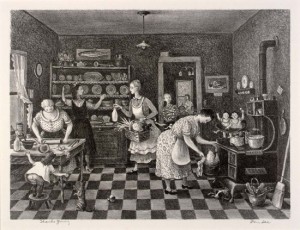The List: Five Feasts in American Art
In honor of Thanksgiving Day, we present a wide array of feasts found in the Smithsonian’s art collections
/https://tf-cmsv2-smithsonianmag-media.s3.amazonaws.com/filer/20111123014003bancketje-small.jpg)
With Thanksgiving Day at hand, the ATM team combed the collections for the some of the best feasts depicted in art. Visit the American Art Museum and its branch, the Renwick Gallery, to see these and other masterpieces of holiday food festivities.
1. Sioux Dog Feast: George Catlin was a self-taught artist who traveled the American West during the 1830s. This painting portrays a feast given by the Lakota people to visiting U.S. government representatives, likely observed at Fort Pierre in 1832. Recounting the event in his Letters and Notes Catlin wrote, “Near the foot of the flag-staff were placed in a row on the ground, six or eight kettles, with iron covers on them, shutting them tight, in which were prepared the viands for our voluptuous feast.”
2. Vegetable Dinner: This 1927 work, painted by artist Peter Blume at the precocious age of 21, depicts a pair of women—one, seated and smoking, the other, standing and chopping vegetables. “Blume was involved with a style called Purism, which emphasized exquisite contours and simplified shapes,” writes museum director Elizabeth Broun. “Still, there’s something in the way the knife slicing away a potato skin is poised against the vulnerable thumb, perhaps to cut more deeply. Blume could find a dark tension in this game of edges and surfaces.”
3. Thanksgiving: During her lifetime, Doris Lee was a popular mainstream artist whose work evoked Norman Rockwell and appeared in Life magazine. This 1935 painting provided a look back at the simpler domestic life many yearned for during the years of the Great Depression. The bustling kitchen is full of preparation for the annual feast, and although the work appears simple in terms of subject, it is filled with countless realistic details.
4. Archelous and Hercules: In ancient Greek myth, the god Archelous took the form of a bull during flood season and carved channels into the earth, while Hercules tore off his horn to create a cornucopia of plenty. Thomas Hart Benton’s 1947 oil painting adapts this legend as a parable for the American Midwest, where engineers worked to tame the Missouri River. The plentiful harvest spilling from the horn represents the future bumper crops farmers would enjoy as a result of this work.
5. Bancketje: This sculpture—named after the banquets often featured in 17th century Dutch still-life paintings—is a literal feast, but one already eaten. Contemporary glass artist Beth Lipman worked with 15 other artisans to create the extravagant installation, piling 400 pieces of hand-blown glass tableware, stemware, candlesticks and serving dishes atop an oak table. The 2003 piece manages to combine an initial impression of abundance with a subsequent awareness of emptiness and decay.
/https://tf-cmsv2-smithsonianmag-media.s3.amazonaws.com/accounts/headshot/joseph-stromberg-240.jpg)

/https://tf-cmsv2-smithsonianmag-media.s3.amazonaws.com/accounts/headshot/joseph-stromberg-240.jpg)